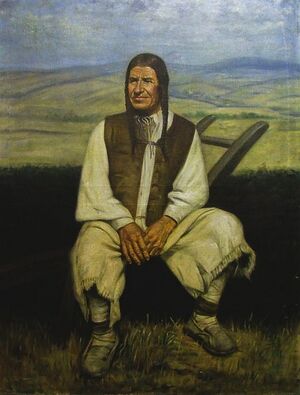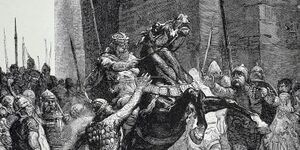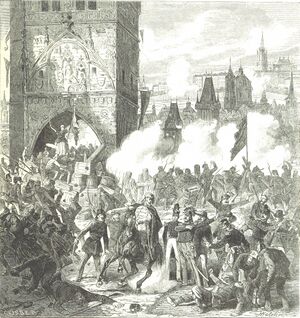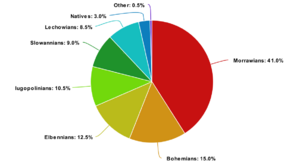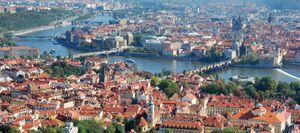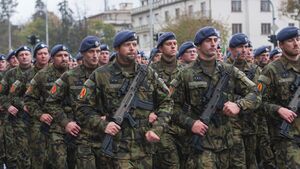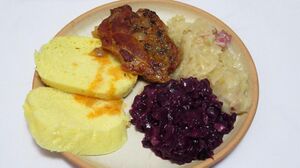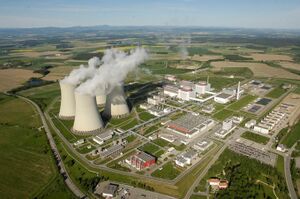Template:Country data Morrawia
The Constitutional Monarchy of Morrawia Morrawská Konsttituchní Monarchie | |
|---|---|
Motto: PRAWDA WZHDY WÝTIEZÍ Truth always wins | |
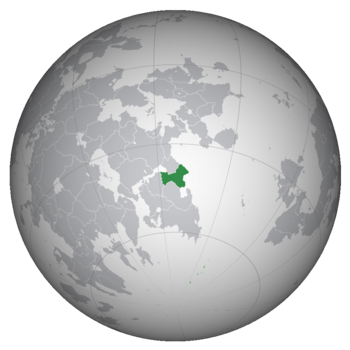 The Territory of Morrawia | |
| Capital and largest city | Praga |
| Official languages | Morrawian, Bohemian, German, Iugopolish |
| Recognised national languages | Morrawian |
| Ethnic groups (2018) | Morrawians (41%) Bohemians (15%) Elbennians (12.5%) Iugopolinians (10.5%) Slowannians (9%) Lechowians (8.5%) Native Morrawians (3%) Other (0.5%) |
| Demonym(s) | Morrawian |
| Government | Constitutional Monarchy |
• His Majesty the King of Morrawia | Charles IV. |
• Prime Minister | Thomas Wallinský |
| Legislature | The Royal Congress |
| The Royal Senate | |
| The Royal House of Representatives | |
| Foundation Independence from Great Bohemian Empire (907 AD) | |
• Morrawian Civil War | 1000-1095 |
• Establisment of The Morrawian Republic | 1574 |
• Imperial Age | 1645-1854 |
• The Morrawian Constitution and Royal Bill of Rights | 15th April 1859 |
| Area | |
• Total | 480,500.63 km2 (185,522.33 sq mi) |
| Population | |
• 2018 estimate | 22 500 000 |
• September 2018 census | 22 501 751 |
• Density | 46.8/km2 (121.2/sq mi) |
| GDP (nominal) | 2018 estimate |
• Total | AUC 804 billion |
• Per capita | AUC 35 733 |
| Gini (2017) | low |
| HDI (2018) | very high |
| Currency | Tollar (TOL) |
| Time zone | UTC0 (UTC) |
| Date format | dd-mm-yyyy |
| Driving side | right |
| Calling code | +415 |
| Internet TLD | .mor |
Overview
The Constitutional Monarchy of Morrawia, commonly called Morrawia is a Federative Constitutional Monarchy in Anteria. It is bordered in the west by Mygona and on the north by Salvan. Morrawia has an estimated population of 22.5 million people. Morrawia comprises of 6 regions (Morrawia, Bohemia, Elbennia, Iugopolinia, Slowannia and Lechowia) and 1 Territory (Wladislaw Archipelago). It has a very varied past ranging from times of absolutist monarchy, republic, imperialism and constitutional monarchy. Morrawia today promotes democratic values across the world and is a significant power in southern Thrismari. Morrawia is also a member of the World Assembly, has signed Global Climate Treaty and is an observer in United Eastern Alliance.
Etymology
The country's native name Morrawa is possibly derived from the Ainegols (Celtic tribe), who inhabited this area regularly starting in a 1st century BC, who named the river Morova (today Morrawa), meaning stream or river, and then named a land after it. The other iteration could be from the other Celtic tribe named Bogoiis, who called this land Marav, apparently meaning field or grassland. The Common name Morrawia was formed in the 1600s from the already mentioned name Morrawa and the suffix -ia, denoting a people or nation. Country is comprised of 6 regions, all with their own names based on rivers, landscape or people, who have been living in the area + 1 Territory. These regions are all made out of many smaller historical regions, which don´t exist today. For example Elbennia (named after the river Elbe) is comprised of historical regions of Osterachia (named after people living there: Österchs), Panonia (named after Latin name for water) and Pylatonia (named after the ancient city Pylatald).
History
Birth of a nation
Morrawia was founded by Przemysell I., founder of the House of Przemysell, which is one of the longest-ruling dynasties in Morrawia´s history. He famously came to the Morrawian region with about 1000 other people, who lived nomadic life up to that point and famously said: "Go people, go and surprise not only the world but yourself too. Create a nation with no limits only of that of a SKY´S." The people at that time were mostly farmers and lived in small villages, one of them was soon to be Capital: Praga, which grew at a rapid rate from its founding in 912. The land then was mostly forests, some marshlands, and mountains on the north and the west. This was the time of rapid expansion of Morrawia and all in all, it was a really unstable period for a young nation. The growth and relative prosperity itself continued for 70 years when during the reign of Yaromir I., the nation was starting to crumble, mostly thanks to the inability of Yaromir to rule himself. The Regions of the nation were sold to the adversaries, people started to riot, and not even the next king, Moymir II. wasn´t able to rescue a dying nation and on the 7th of March, the nation dissolved and an Age of Chaos began, continuing well until the year 1095, where major fighting stopped, but the region was divided amongst many little kingdoms, duchies and earldoms.
Peace after the Age of Chaos
Eventually, the nation was put back together by Wenceslaus I. of House of Carthia as a Grand Duchy of Morrawia, losing its previous, somewhat shadily acquired, Kingdom status in a Chaos that preceded. Even though the rule of Carithians of Morrawia wasn´t the longest (only 3 Dukes), the greatly stabilized the nation, improved the lives of citizens, even expanded territory. But as was Boleslaw II. (last Carithian Duke) dying, he whispered the prophesy, that the House of Przemysell must return to throne and reign over the land, otherwise, there will be no Morrawia. His subjects listened, searching for a descendant of Przemysells and they found him, living as a lumberman in the woods of Shúmmawa Region. They asked him to be their king, he accepted and he restarted the reign of the House of Przemysell in Morrawia for approximately the next 500 years. He himself was named Przemysell the Great and starting with him, Morrawia was now definitely a Kingdom, title, it never lost to this day, with one notable exception in a far future.
Middle Ages
Things were looking great, the formation of large cities began at this time, although, majority of the population were still living in villages. But changes were made elsewhere too like economy or agriculture. Nation shrank and again expanded numerous times over this period encompassing in its peak almost all of SE Thrismari going as far as touching Sunadic Ocean, Torgea Strait, and even Kaldaz Ocean at once. That during the reign of Borziwoi III. and Wladislaw I. The next king Przemysell VI. allowed women to become rulers. This was revolutionary. There was Ludmille I., favorite among the people, and lastly Anezh I., who was sadly, the last monarch wearing the symbols, and ruling the Morrawia as Przemysell. She, even more, expanded the Kingdom, prolonging the border along the Kaldaz Ocean, but was sadly assassinated by Duke of Beronil, one of the rulers of the northern subdivision of Morrawia at the time making the House of Przemysell extinct and declaring himself as a ruler. He was nicknamed Albert The Killer for his cruelty. This was a dark period for Morrawia, as people were dying in the hands of Albert, it lost a significant amount of territory and his son Ferdinand handed power to Nobility and subsequently killing himself in Praga Castle. This was the start of a short, weird but still interesting era: The Age of Nobility.
Morrawian Republic
Age of Nobility was a 27-year long period, where The Monarchy was abolished and the Federal Republic of Morrawia was established. The FIRST Constitution in the history of Morrawia was written. This was the first attempt to create a truly representative democracy in the nation. Morrawia was reorganized in terms of counties inside a nation. There were many counties, which were part of the historic regions, now called States. If someone won a majority in the county, the whole county was theirs, if someone won the majority of counties in that given state, the whole state is theirs. This system is called the electoral college and is not used today in Morrawia. But things weren´t that optimistic. People COULD elect representatives, but the representatives were from the nobility and regular people weren´t allowed to run in elections. Also, women couldn´t vote, only men, and also, there was a VOTING FEE involved with voting nad not everybody could afford it. At the end of the day, it was an imperfect system attacked constantly by Monarchist Knights, Raiders, and other groups of people who didn´t like the new Republic. After 27 years in 1601, it was decided by the ruling body, Republican Council voted on ending the Republic and handing the power to the selected Royal House: House of Ollomócc. This was passed by the majority because a lot of States were fighting with raids, not enough food, and many other problems, that were undermining the Republic, and many thought, that having a Central Figure, although with some sort of Council too would be a better idea. So they handed the power to them, starting a new era of Morrawia with Ollomóccians in charge...unofficially called CONSTITUTIONAL AGE which continued up until the 20th Century. The same year new Morrawian Royal Crown was created. Up until that point Morrawian kings used many crowns, some were lost, some were sold. So this new flag was meant to be grandious jewel of Morrawia. And it is to this day. It was also at this exact time, when Unitary Royal System was introduced uniting the measurements in the nation. Also there were new changes to the government. Now Kingdom of Morrawia, Kingdom of Bohemia, Grand Duchy of Elbennia, Margraviate of Iugopolinia, Principality of Lechowia and Principality of Slowannia + 1 Territory had and still have an elected official, who would rule them respectively: Governors who operate similarly to Prime Minister.
Constitutional Monarchy and the time of an Empire
The first king of reestablished Morrawian Monarchy Arthush I. still had significant power over now so-called Royal Council so he used it to reorganize the nation in all aspects of administration and life to be more efficient and more manageable. He let create a brand new Morrawian Royal Crown, which would be crown for all kings for years to come. He was a very successful and favorite ruler. But at the end of his rule, something happened. By the end of his life, he developed schyzophrenia and began doing very bad decisions. He even started executing people. The situation got so bad, that the military stepped in and deposed Arthush. This was good for a moment until the military leadership, who promised stability and freedom became a authoritarian regime with General Jan Krallowec being its first Supreme Leader in the newly formed Morrawian Empire. Folloing this, the king died one year later and one of the darkest chapters in Morrawian history began. These military leaders were often cruel with exceptions. They drained Morrawia of its money and resources, the killed the opposition, burned towns and villages, ravaged the whole counties but most importantly, they began the program of colonialism. With slaves and other individuals from Thuadia and other places brought to Morrawia, there was a massive influx of people. These people lived hursh lives as sub-humans almost. Morrawian nationality was the only one allowed with protestantism also being the one and onyl religion. Massive purges of Native Morrawians and Catholics were made. People suffered and the country wasn´t well led. This continued for almost 200 years. Its also important to say, that two leaders: General Pawell Trzeshttínský and General Mirrosllaw Jellínek were to the certain point good leaders, who actually tried to improve lives and the situation in Morrawia. This madness, which was specificaly critisized by the military during the rule of Arthush I. was enough to get people going. Several times during this regime, people rose up and started protesting. They were always put down with guns. But starting with the death Mirrosllaw Jellínek, who people generally liked and with the his brother taking over, people have had enough. There were protests everywhere. And by the reign of General Borris Krallowec, direct decendant of Jan Krallowec, people were protesting everywhere. His whole reign was focused on putting down these rebelions. And thats where Wollodimír The Curly comes around. Born into noble family in Slowannia, he decided that he wanted to take advantage of the crumbeling system and began his big plan. He rallied people and big parts of army behind him. And 1853, he began the fight with The Empire. With his loyal soldiers he occupied Praga and killed every Junta sympathiser they saw. After that coordinated attacks on the main regime infrastructure weakend the Junta even more and the whole regime started crumbling. In The Battle of Freedom right in front of Praga he defeated the army of General Krallowec and the whole regime fell. From that day, Morrawia is free, which is remembered on 28th October as Freedom Day.
Independence and modern times
After the war, few other kings ruled the lands with absolute power given to them by the now new TWO-CHAMBER Congress to rebuild the nation and get it back on track. Rostislaw III., son of Wollodimír industrialized the nation. He witnessed the creation of The Royal Company (also called The New Country Company) created by Francis Shoren which was a "colonial" company. It managed various nations which joined Morrawia after the fall of Military Junta. It was reformed and wasn´t and imperialist tool anymore. The collapse meant massive migrations all across Anteria and especially from Thuadia. The situation with migrants became so severe, Rostislaw called Francis, who dreamed of own country somewhere far from Morrawia, to find another land for them. Many Morrawian officials were sent to find some land and they found it in Meredonne, the most eastern continent of Anteria, on the most Eastern tip of the big island. This was the land for all the migrants, the country of Respublica Hyliana. The year was 1867 and after the founding of the new country, Colonial Program of Morrawia desolved after few month as it was too financialy difficult to handle and also didn´t have any purpose anymore as all the little nations either joined Morrawia or they declared independence. These "nations" were very often tribes or tribe federations in some territories of mainly Thuadia. And a bright future continued. Thomas II. used these powers to allow women to vote in 1899. Charles I. finished the process of rebulding and trials against Junta (mainly people behind the Empire, not the nation itself) and Morrawia was finally stabilized. So he gave away his emergency powers to the Congress and became representative figure. Following that, Chales I. was the last one of his dynasty (House of Tattrany) and he needed to do something about it. So he reached out to Iugopolinian House of Walldstine to take a throne. Wladislaw Walldstine accepted and was crowned right after Charles´s death in 1925. House of Walldstine is very popular to this day and is labeled as "Uniting House" thanks to their speeches, proposals to government and more. It was Charles II. who was responsible for lobbying the Congress. He wrote laws and proposed reforms, which were then voted for. Thanks to this, Morrawia experienced Second Golden Age of Prosperity. Thanks to minimal involvement and stability during an Era of Civil Wars and more significant involvement in previous Great War, where Morrawia aided The Alliance with suppies but mainly manpower. Morrawia engaged in countless battles and finally standing victorious in the war, Morrawia was able to thrive even during Era of Civil Wars. Current King, Charles IV., is modern, some would say an unconventional figure, who supports freedom, is advocating for rights to minorities (racial and genderwise) and is beloved by the people for his charismatic look and for the ability to represent Morrawia and its many regions at home and abroad.
Geography
The Morrawia lies mostly between latitudes 48° and 51° N and longitudes 12° and 19° E.
In Morrawia, there are main two river basins: Elbe River Basin and Morrawa River Basin. Both rivers originate in Izzer Mountains in the north of the country. It's one of two mountain ranges in otherwise slightly hilly and also, moving closer to the coast, very plain country. The other mountain range is in the west and is called Great Tattras Mountains. The highest point in the country is Mount Snow Peak (Biélaia Snieha) - 2501 m.
Elbe River flows to the west to the Torgea Strait. Morrawa River on the other hand flows to the southeast, straight through Praga and into the Bay of Morrawa. There are also amongst others, 4 smaller major river: Vágh River, Nuttra River, Sésaw River and Wollttaw River.
There are 7 national parks mostly in the west. These are: Izzer Mountains National Park, Modrrá Wodda Canyon, Shúmmawa National Park, Great Tattras National Park, Bescidian Plateau, Sunadic Marshlands Terittory and Przemysell National Park + 17 other smaller nature reserves. There are also some nature reserves on Wladislaw Archipelago.
Climate
Morrawia has temperate climate, with oceanic climate in the east and more contintal in the west. This causes the Western and Central part of the nation to have bigger difference between temperatures during summer and temperatures during winter. So whereas East gets milder (but still hot) summers and mild winters, Central and Western part of Morrawia gets very hot summers and snowy, windy and cold winters.
The coldest month is usually January, followed by February and December. During these months, there is snow in the mountains and sometimes in the cities and lowlands. During March, April, and May, the temperature usually increases, especially during April, when the temperature and weather tends to vary during the day. Spring is also characterized by higher water levels in the rivers, due to melting snow with occasional flooding.
The warmest month of the year is July, followed by August and June. On average, summer temperatures are about 20–30 °C higher than during winter. Summer is also characterized by rain and storms. Autumn generally begins in September, which is still warm and dry. During October, temperatures usually fall below 15 °C or 10 °C and deciduous trees begin to shed their leaves. By the end of November, temperatures usually range around the freezing point.
Throughout the year, the coldest temperatures are recorded on Wladislaw Archipelago.
Demographics
Morrawia was once very homogeneous societe thanks to the pressure on conquered territories to assimilate into the Morrawian culture and identify as Morrawians. Recent trends, starting with the first king of House of Walldstine however discouraged this behaviour and this was met with overwhelming support from all the regions in Morrawian Monarchy. So the demographic composition is as follows:
Language
Morrawia has many languages and many of them are even official. First one is Morrawian. Morrawian language is a Slavic language, written in Latin script. Spoken by over 24 million people, it serves as the main and official language of the Morrawia and all of its regions. Other languages spoken in individual regions are Bohemian, German, Iugopolish + many of native languages of Native Morrawians (broad term for every native tribe or community). Many of these languages are very, very similar to Morrawian, but are ultimately different with different alphabets, systems, etc. These were made official in 1926 during the reign of Wladislaw I. and ratified by The Congress.
Many of these languages are very similar to Morrawian, Bohemian being closest to it, though they are written little bit differently, spoken word can be understood by any other language speaker, with exception of Native languages and German, which is a Germanic language instead of Slavic one. Morrawian is a fusional language with a rich system of morphology and relatively flexible word order. French is a wierd one amongst all the languages. Wladislaw Archipelago was used during the reign of an Empire to house slaves from all over the word.
These languages are tought in schools accordingly with Morrawian as a first mandatory language and then languages spoken in regions. These second, optional, languages can be added to school curriculum by local Congresses. More on that, other languages spoken in a kingdom can be ofcourse tought in schools, though only through school courses (except the Common language, which is mandatory). Bohemian, German and Iugopolish are these languages, spoken in Bohemian, Elbennia and Iugopolinia respectively. Regions of Slowannia and Lechowia speak Morrawian with a slight dialect and don´t have their own language.
Here we will analyze Morrawian:
It has 31 letters. The full list of letters is: Aa Áá Bb Cc Dd Ee Éé Ff Gg Hh Ii Íí Jj Kk Ll Mm Nn Oo Óó Pp Qq Rr Ss Tt Uu Úú Ww Xx Yy Ýý Zz. The stress is always on the first syllable. Words can be relatively flexibly move around the sentence and still make sense. Foreign words are written exactly like they are in that particular language with possible acception of pronouns, though its not always the case. There is occurance of double letters. These double letters are never in the beggining of the word and are always behind a vowel. Aside from that, no official system exist on double letters, with words naturaly evolving through history and people needing to simply remember the words. There are also sounds, the standard alphabet doesn´t have a letter for so there are lots of Chs, Czs, Tzs, etc. The whole language dates back to the 7th century.
Religion
Religion has been historically a religious nation, though Morrawia is constitutionaly irreligious country. There are many religions in Morrawia, with one of them being Morrawism, an offshoot of Protestantism, officially called Church of Morrawia. Other notable religions are Protestantism and Catholicism and given, that there are many native tribes still living in Morrawia, they have their own religions too, completely supported by the government with exception of bloody rituals and similar gruesome stuff. There is also growing Irreligious community since the 20th century and is 2011 census, almost 12% of the population is irreligious.
While absolute majority of the country is either Protestant or Morrawan, almost all of Elbennia is of Catholic faith. This is due to various factors, with one of the most important being, that Elbennia isn´t Slavic, it has Germanic culture, quite different from the rest. Catholicism appeared in the area of today's Elbennia in the 1st Century AD. Protestantism evolved in the rest of the country in the 1500s as Slavic population didn't really got along with catholics through the centuries. So they accepted Protestantism as they´re main religion, as it was more liberal. Today, it's mostly in Iugopolinia, Lechowia and in some parts of Slowannia with hotspots around the Bohemian coast.
Both Catholic and Protestant faith believe in one God. Protestantism being more free is also more prevelant in the country coming to Morrawia from abroad. Morrawism formed in the times of Military rule as a mean of protest against establisment. Starting in Bohemia in the little town of Warcawisse, created by the local protestant priest Addam z Warcawiss, Morrawism quickly spread though Morrawia especially in Iugopolinia, Slowannia and Bohemia thanks to its friendly rules like no compulsory donations, no gold in churches, only other metals, no celibacy or fasting. Priests could have families and people could divorce. Women could become church dignitaries etc. Today, this religion is strong mainly in Morrawia, Bohemia, Slowannia and little bit in Lechowia with some hotspots in Elbennia and Iugopolinia and also on Wladislaw Archipelago. The head of The Church of Morrawia is Morrawian Monarch, first being Wollodomir, The Warrior of Thrismari, titled Supreme Head of The Church of Morrawia.
Ethnicity
Morrawia was and still is very multi-lingual and multi-ethnic nation. This phenomenon can be traced to the founding of the nation where Przemysell I., first King of Morrawia was called formally "HEAD OF ALL MORRAWIAN PEOPLE". By Morrawian people he also meant BOHEMIANS, ELBENNIANS, IUGOPOLINIANS, SLOWANNIANS and LECHOWIANS, which were ethnic groups, that voluntarily joined Morrawians, to create one strong state.
So although Morrawia was viewed as one nation and for lot of its history, it was Duchy of Morrawia, which the most dominant amongst the nations, Morrawia was still a federation with Dukes, who ruled their regions of Morrawia and were directly subjects to the King or Queen. Nowadays Morrawians make up 41% of the population, Bohemians 15%, Elbennians 12.5%, Iugopolinians closely follow with 10.5%, Slowannians are 9% of the population, Lechowians 8.5%, Native Morrawians (which is bigger group composing of all hundreds the Native tribes in Morrawia) make up 3% of the population and other people, like immigrants or expats 0.5%.
Health
Public Healthcare in Morrawia is one of the best on Anteria. Rating TOP 100 in the region, standard of healthcare is generally high. The affordability and standard of medical treatment has even seen the country emerge as a popular destination for medical tourism on Anteria.
It is compulsory to have health insurance in Morrawia, whether trhough a public or private health insurance provider. Citizens, residents and anyone working for a Morrawian employer are automatically insured under the country´s public healthcare system and pay monthly contributions. Many doctors are in public hospitals though many are in private ones and the healthcare there is just as excellent. Morrawia provides free medical care to all citizens, permanent residents and foreigners working for a local company through compulsory contributions to an approved Morrawian health insurance company. Employers, it is mandatory to pay a portion of the monthly fee with the employee contributing the remainder of the fee. Pharmacies are widely available all across Morrawia, with some opened 24/7. Some of them are even attached to hospitals. Emergency services in Morrawia are generally good, as are ambulance response times. In the case of an emergency, dial 117.
Education
Education in Morrawia includes 4 levels of education: Pre-School, Elementary, High and Final/Post-High. For students ages two to five, there are preschools called Community Schools that are generally not state-funded until the years before elementary school. There is also a number of private schools is present across the country. Elementary school is mandatory for children from ages six to sixteen. After that, some students leave formal education altogether, while other students attend other types of school. Enrollment in public schools is fairly high, though these figures do not document active student engagement.
Morrawia's education system is governed by the Ministry of Education with 12.7% of the Morrawian Government Expenditure going into it. Elementary school consists of nine grades and is grouped into two stages:
After preschools, kids usually enroll into the nearest county elementary school. There, they learn in a same class 9 years. The last year, children either go to elementary school for another year or they can go study in another school, specifically Special Vocational Schools (SVS), which consists of 5 years of studying their subject of choosing. There are also two other options. If they finish the last year of elementary school, they can attend 4-year Academy, with a specific specialization to one subject. Option B is to go to 8-year Academy in the after 5th grade (instead of going to 6th grade), with four years of mandatory learning and then option to continue another four (optional) years or go to SVS. In the last year of either SVS or Academy, they must pass National Finals Test to pass the school. Every Region have their own NFTs, but National Curriculum exists, which give regional school districts a framework for not only NFTs, but the whole education in general.
The next big step is either going straight to work, or going to University. Every Region has at least 3 Universities and there are 2 in Wladislaw Archipelago. The length of Universities varies from 6 to 10 years in total. The best universities are Wollodimír University in Praga, Walldstine Royal College, University of Tattrany and Overseas University of Trzebbícz.
Largest Cities
| Rank | Region | Pop. | |||||||
|---|---|---|---|---|---|---|---|---|---|
| 1 | Praga | Kingdom of Morrawia | 4,539,961 | ||||||
| 2 | Berno | Kingdom of Morrawia | 2,029,794 | ||||||
| 3 | Áshen | Kingdom of Bohemia | 1,236,865 | ||||||
| 4 | Pillsan | Kingdom of Bohemia | 1,097,162 | ||||||
| 5 | Olomócc | Kingdom of Morrawia | 793,766 | ||||||
| 6 | Elbennitz | Grand Duchy of Elbennia | 525,973 | ||||||
| 7 | Walldstine | Margraviate of Iugopolinia | 392,490 | ||||||
| 8 | Tattrany | Principality of Slowannia | 354,917 | ||||||
| 9 | Zelline | Principality of Lechowia | 295,738 | ||||||
| 10 | Ostteraw | Principality of Lechowia | 130,024 | ||||||
Government
The Government of The Constitutional Monarchy of Morrawia exercises executive power in the Morrawia. The members of the government are the Prime Minister of Morrawia, the Vice (Prime) Minister and other ministers. It has its legal basis in the Constitution of The Constitutional Monarchy of Morrawia. The government is led by the Prime Minister, who selects all the remaining ministers at hand and it's elected for 5 years. The Government of Morrawia is responsible to the Royal House of Representatives.
The Prime Minister is appointed by the Morrawian Monarch. The current Prime Minister is Thomas Wallinský. The current government was sworn in on July 27th, 2020. It has 16 members + 3 non-cabinet members and a prime minister. It consists of the following members:
Prime Minister - Thomas Wallinský (Progressive Party)
Vice Minister - Cyrill Hayduk (Progressive Party)
Minister of Foreign Affairs - Simmone Jirráskowá (Morrawian Party)
Minister of Energy - Dawwid Rozsttál (Progressive Party)
Minister of Treasury - Karolline Thammowá (Progressive Party)
Minister of Defense - Radim Fiala (Morrawian Party)
Minister of Justice/Attorney General - Friedrich August (Morrawian Party)
Minister of Commerce - Ondřej Pavelec (Progressive Party)
Minister of The Interior - Iwan Barttosh (Federalist Party)
Minister of Health - Emmil Nowák (Social Democratic Party)
Minister of Labour - Vojtěch Opat (Social Democratic Party)
Minister of Education - Taddek Shálla (Progressive Party)
Minister of Transportation - Sebastian Rëtzmayer (Progressive Party)
Minister of the Environment - Wladimmír Kucherra (Movari Union Party)
Minister of Culture - Josseff Hawell (Morrawian Party)
Minister of Agriculture - Monnika Sedláchkowá (Social Democratic Party)
Director of National Security - Walter Schölz (non-affiliated)
Trade Representative - Chestmír Zednník (non-affiliated)
Chief Economic Advisor - Stella Rháttowá (non-affiliated)
| Region/Territory | Population | Capital | Governor |
|---|---|---|---|
| MORRAWIA | 9 225 269 | Praga | Raddek Potmieshill (Progressive Party) |
| BOHEMIA | 3 375 930 | Pillsan | Jana Stránská (Constitutionalist Party) |
| ELBENNIA | 2 812 571 | Elbennitz | Johaness Engel (Democratic Party) |
| IUGOPOLINIA | 2 362 634 | Walldstine | Alexandr Zawadzký (Progressive Party) |
| SLOWANNIA | 2 025 208 | Tattrany | Pietter Rzehák (Federalist Party) |
| LECHOWIA | 1 912 256 | Osterraw | Zuzzanne Dosttálowá (Conservative Party) |
| WLADISLAW ARCHIPELAGO | 786 132 | Trzebbícz | Addam Tábborský (Social Democratic Party) |
Military and Foreign Relations
Morrawian Royal Forces consist of the Royal Army (also called Royal Legion), Royal Air Force, Royal Navy, Royal Coast Guard, Royal Marines and more. The armed forces are managed by the Ministry of Defence. Morrawian Monarch is a Commander-in-Chief of the armed forces. In 1658 the army transformed itself into a fully professional organization and in 1954, conscription was abolished. It currently has 345,347 active personnel, 75,375 reserve personnel. Because of that, a military alliance with neigboring nations was considered. The armed forces are charged with protecting Morrawia and its allies and promoting global and regional security interests.
Morrawia has ranked as one of the safest or most peaceful countries for the past few decades. It is a member of the World Assembly. The embassies of most countries with diplomatic relations with Morrawia are located in Praga.
The Prime Minister and Minister of Foreign Affairs have primary roles in setting foreign policy, although the Monarch also has influence and represents the country abroad. Royal Investigation Bureau (RIB) is an intelligence agency responsible for espionage and combating major crimes, which threaten the security of The Constitutional Monarchy of Morrawia within. It operates mainly on the territory of Morrawia. National Intelligence Agency (NIA) doesn't solve crimes, but rather gathers information and engages in espionage outside Morrawia and thus helps form Morrawian Foreign Policy and protects The Constitutional Monarchy of Morrawia from external threats. It also protects embassies abroad.
Morrawia has bigger ties with its neighboring nations, as well as many others across the world with Morrawian officials have frequently supported dissenters in many totalitarian regimes in the past and this stand won´t probably change in the future either.
Economy
Morrawia has a developed, high-income export-oriented social market economy based in services, manufacturing and innovation, that maintains a welfare state. Monetary policy is conducted by the Morrawian Royal Bank, whose independence is guaranteed by the Constitution.
| Economic Indicators |
|---|
| Economic Capitals: Praga, Áshen
Currency: Tollar Fiscal Year: 6th March of this year - 5th March of the next year GDP (nominal): 804 BILLION AUC GDP (nominal) per capita: 35 733 PER CAPITA AUC |
Science and Technology
Morrawia have a long and well-documented history of scientific innovations. Today, Morrawia has a highly sophisticated, developed, high-performing, innovation-oriented scientific community supported by the government, industry, and leading Morrawian Universities. Morrawian scientists are embedded members of the global scientific community. They contribute annually to multiple international academic journals and collaborate with their colleagues across boundaries and fields.
Communication
Morrawia ranks pretty high in internet speed with downloading speed from 50MBits/s to 1GigBits/s. There are over 10 000 WISPs as of 2020. Major phone companies M-Phone, Royalty and Bohemia United provider all services available to customers. Prices went significantly down after the privatization of Government Operated MCOM.
Culture
Art is a huge part of Morrawia´s history. Even before Morrawia, on the same territory, where Morrawia today lays, ancient tribes made little statues, cave paintings, ceramic dishes and so on. This was mainly the work of two tribes: Bogoiis and Ainegols. Ainegols inhabited the territory as far as 1st century BC and Bogoiis, who basically replaced them were predecessors of Bohemians, ruling the area from the 2nd to the 4th century when they merged into Bohemians. Another era of art can was during a reign of Borziwoi II., who ushered Morrawia into the First Golden Age, thanks to peace, sucessful trade and a relative wealth of the nation, artist started to pop-up, making paitings of king and his family and even regular people. House of Przemysell knew this was to everybody so they encouraged it during their rule. During the rule of Military Junta, not much art was made. Sculptors, painters and every artist was either used to help the Junta, arrested, killed or prosecuted. After liberation of Morrawia by Wollodomír The Warrior of Thrismari, artfroms exploded with painter like Mikulásh Allesh, Wojtiech Hinnais, sculptor Wenceslaus Mysellbak and many others. 20th century was another boom for art with Royal Art Festival founded in 1941 and Royal Art Gallery established in Praga in 1945. Both the festival and the art gallery continues to operate to this day.
Architecture is another thing, which has its roots deeply ingrained in Morrawia. As mentioned before, with acception of some cave tribes with little significance, Ainegols, were the first to inhabit this land building first fortified villages made of stone and wheat. During the reign of the first Przemysells, people were living long houses with typically 5 families living together in fortified villages. These buldings were made out of stone, wood and a roof was thatched. Between 13th-15th century, "Village and Town colonization" took place. This was event encouraged by kings at the time for people to settle furtherest lands of Morrawia for some money compensation as well as free land. By this time, many bigger town started to pop-up with 1 or two stories. The biggest example of this was in Prague, where there were entire neigborhood built like this. At this time something called Morrawian Renaissance Style was present in the country. This was a mix between Gothic and Renaissance architecture style which resulted in my unusual builds to be built. During 19th and 20 century, new architecture forms showed-up in Morrawia such as Cubism, Neo-Gothic, Neo-Renaissance and other. From the 90s to the mdoern day, Morrawia is experiencing revival of new styles with modern building blending into the ancient cities around them.
Other forms, such as literature (Famous writer Franzs Kafka, born in Elbennia), Music and Theatre and Film are also rooted into the culture heavily. There are annual music festival, for example on Independence Day, or during the Holidays. Royal Theatre of Morrawia is a shining beacon in Morrawia and a big pride of the whole nation. Its the biggest theatre in the nation with frequent historical, patriotic and fun plays every day. Lion Studios in Pillsan serves as the biggest film producing studio in the nation from its founding in 1918. Related to this, Annual Lion Awards take place in Royal Theatre to award the best work in cinematography. Alligned with this are numerous other independent Musical Festivals (Federation Morrawia), Film Festivals (One World Film Festival) and countless others like pride parades, love festival, food festivals, nature festivals and more...
Talking about Film and things related to it, this brings us to Media. Journalists and media enjoy a fairly high degree of freedom. There are almost no restrictions due to the First Amendement of The Standard XI. in the Royal Bill of Rights, which is a part of The Contitution of The Constitutional Monarchy of Morrawia. The Morrawian press was ranked in TOP 10 for the most free press in the World Freedom Index by Thrismari Press Assosiation. The most watched main news program are MNN (Morrawian News Network), Nova One, RCNN (Royal Cable News Network) along with several other local news networks in each region. A news webpage in Morrawia is rcnn24.mor, which is owned by RCNN – the only national public television service – and its 24-hour news channel RCNN24. Other public services include the Royal Radio and the Morrawian News Agency (MNA). For privately owned television services, there is MNN, the most popular channel in Morrawia.
The best-selling daily national newspapers are The Old Herald (average 8.15M daily readers), Union (average 5,600,000 daily readers), The Crown Post (average 1,270,000 daily readers) and Daily Journal (average 750,000 daily readers).
Sports
The most watched events in Morrawia are Morrawian Ice Hockey World Cup and Ice Hockey Championship. The two leading sports are baseball and ice hockey. Other most popular sports according to the size of the membership base of sports clubs include football, tennis, volleyball, floorball, golf, ball hockey, athletics, basketball and skiing. A common sport is hiking. For hikers, thanks to the more than 120-year-old tradition, there is a Morrawian Hiking Markers System of trail blazing, that has been expanded ever since. There is a network of around 80,000 km of marked short- and long-distance trails crossing the whole country and all the Morrawian mountains.
Cuisine
Morrawian cuisine is marked by an emphasis on meat dishes with pork, beef, and chicken. Goose, duck, rabbit, and venison are served. Fish is also very common even served on Christmas as a special dish.
Morrawian beer with the first brewery is known to have existed in 993 and Morrawia has a really high beer consumption per capita, almost 102 liters. Many famous brands of bear are brewed in Morrawia and its regions, such as: Pragant, The Monastery and Elbennium.
Infrastructure
The road network in Morrawia is 229,890 kilometers long. There are 13,100 km km of motorways as of 2019. The speed limit is 50 km/h within towns, 90 km/h outside of towns and 200 km/h on motorways.
Federal Highway System of Morrawia started contruction in 1925 with a passage of National Highway Act of 1925. Since then, many kilometres of highways were built with federal government giving most of the money to the regions, who pay only small share of the price for new infrastructure. By 1956, 41% of all highways were built. In 1990, 91% was built and contruction began on Wladislaw Archipelago. By 2005 all highways were built in Morrawia and its territories. All major cities were connected along with many smaller but still important towns and industry centers. From this, smaller highways and speedways are being built to this day to connect less relevant parts of the country and most importantly, Morrawia with the rest of the world.
Morrawia has one of the densest rail network on the Anteria with over 27,594 km of tracks. Of that number, 15,591 km is electrified, 7,617 km are single-line tracks and the rest are double and multiple-line tracks. Royal Railways of Morrawia is the main railway operator in Morrawia, with about 190 million passengers carried yearly. Maximum speed is limited to 160 km/h. In 2006, new model of highspeed trains entered the railways, called White Lion.
Przemysell International Airport in Praga is the main international airport in the country. In 2019, it handled 24.3 million passengers. In total, Morrawia has 52 airports with paved runways, ten of which provide international air services in Praga, Áshen, Pillsan, Berno, Ostteraw, Ollomócc, Elbennitz, Walldstine, Zelline and Tattrany. This coincide with the biggest Morrawian cities with the majority of international airport being in either Bohemia or Morrawia.
Energy
Production of Morrawian electricity exceeds consumption by about 204 TWh per year, which are exported. Nuclear power presently provides about 41 percent of the total power needs, its share is projected to increase to 60 percent in the near future. By 2019, 28 percent of electricity was produced by steam and combustion power plants (mostly coal); 41 percent by nuclear plants; and 31 percent from renewable sources, including hydropower, windpower, biomass and solar energy. The largest Morrawian power resource is Nowé Hraddy Nuclear Power Station, with other in Áshen, and other 8 either Morrawia or Bohemia.
Many Hydro Power Plants are located in Elbennia as the hilly terrain allows it. Big solar pannel fields are located all over the country and the topic has become increasingly controversial in recent years. Many politicians want to ban these fields as they are used only to tunnel money and not actually produce eletricity. Wind turbines can be found all over Morrawia and is the main source of energy on Wladislaw Archipelago..
Morrawia is reducing its dependence on highly polluting low-grade brown coal as a source of energy. Natural gas is produced in Principality of Lechowia, roughly three-fourths of domestic consumption, and from foreign companies, which make up most of the remaining one-fourth. Gas is 86% from Margraviate of Iugopilinia and the rest is again from foreign nations. East of Kingdom of Morrawia also has big oil and gas deposits.


